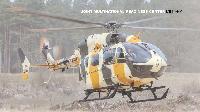Фотографии
-
A UH-72A Lakota on final approach to Hohenfels Army Air Field’s runway 27. On the left, an OPFOR Lakota is hover taxiing back to its parking position while left of the runway, two UH-60 Blackhawks can be seen on medevac duty.
Самолёты на фотографии: Eurocopter EC.145 / UH-72 Lacota - International - 1999Sikorsky UH-60 Black Hawk / S-70 - США - 1974
-
The JMRC's last UH-1H Hueys flew alongside the UH-72A Lakota in 2010 and early 2011 before they were withdrawn from use in April 2011. The camouflage was meant to resemble Mil Mi-24s.
Самолёты на фотографии: Bell UH-1D Iroquois / Model 205 - США - 1961
-
The UH-72As at JMRC are flown by experienced instructor and standardisation pilots on AH-64 Apache, UH-60 Blackhawk and CH-47 Chinook helicopters. They use the same tactics and techniques and therefore replicate a realistic scenario.
Самолёты на фотографии: Eurocopter EC.145 / UH-72 Lacota - International - 1999
-
Four of the Joint Multinational Training Center UH-72As are painted in the bruised banana scheme to represent opposition forces. The other four have a green colour scheme for observer/controller duties.
Самолёты на фотографии: Eurocopter EC.145 / UH-72 Lacota - International - 1999
-
The UH-72A Lakota entered service with the Joint Multinational Training Center on April 28, 2010. One of the Center's Lakotas, UH-72A 09-72105, is painted in this eye-catching, three-colour paint scheme, known as the 'bruised banana', designed to replicate enemy helicopters.
Самолёты на фотографии: Eurocopter EC.145 / UH-72 Lacota - International - 1999
-
The Lakota is flown with a crew of three. The pilot and co-pilot are both observer/coach and the crew chief is the flying maintainer.
Самолёты на фотографии: Eurocopter EC.145 / UH-72 Lacota - International - 1999
-
This UH-72A, serial 09-72100, was the 100th Lakota delivered to the US Army.
Самолёты на фотографии: Eurocopter EC.145 / UH-72 Lacota - International - 1999
-
The Blue air scenario, for which the JMRC’s green Lakotas are used, involves replicating a number of scenarios including reconnaissance, security, attack, medevac, command and control and limited air assault movement. Here a UH-72A practices with underslung loads.
Самолёты на фотографии: Eurocopter EC.145 / UH-72 Lacota - International - 1999
-
An OPFOR UH-72A awaiting clearance for take-off at Hohenfels Army Air Field.
Самолёты на фотографии: Eurocopter EC.145 / UH-72 Lacota - International - 1999
Статьи
- Airscene
- A.Avin - LanceR /Military/
- A.Mladenov, K.Grozev - Carpathian Vipers /Military/
- A.Spaeth - Reinventing Alitalia /Commercial/
- L.Nordeen - Still Got Sting /Military/
- M.Ayton - In a Town called Yuma /Military/
- M.Ayton - Testing the Combat Edge /Military/
- M.Scharenborg, R.Wenink - New Falcons /Military/
- N.Pittaway - A Slick Brazilian /Commercial/
- N.Pittaway - Twilight of the Great Hunter /Military/
- R.Niccoli - Italian Special Ops /Military/








